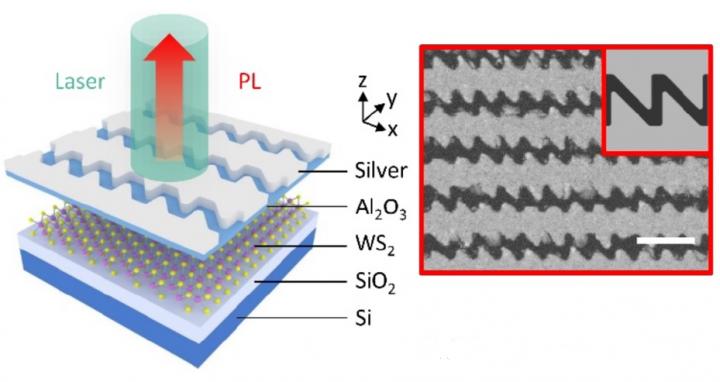Silver sawtooth creates valley-coherent light for nanophotonics

After excitation of the device with green laser light (green), coherent fluorescence occurs (red) thanks to the silver saw tooth (right panel). The scale bar is 500 nm Credit: Han and Ye, University of Groningen
Tungsten disulfide has interesting electronic properties and is available as a 2D material. 'The electronic structure of monolayer tungsten disulfide shows two sets of lowest energy points or valleys,' explains Associate Professor Justin Ye, head of the Device Physics of Complex Materials group at the University of Groningen.
One possible application is in photonics, as it can emit light with valley-dependent circular polarization – a new degree of freedom to manipulate information. However, valleytronics requires coherent and polarized light.
Unfortunately, previous work showed that photoluminescence polarization in tungsten disulfide is almost random at room temperature.
Valleys
'Tungsten disulfide is unique in that these two valleys are not identical,' says Ye. This means that to create linearly polarized light, both valleys must respond coherently to generate light in the photoluminescence. 'But the intervalley scattering at room temperature largely destroys the coherence, so appreciable coherence is only achieved at very low temperatures that are close to zero.'
Ye and his postdoctoral researcher Chunrui Han (now working at the Institute of Microelectronics, Chinese Academy of Sciences) therefore tried a different approach to create linearly polarized light by using a plasmonic metasurface, in the form of a silver sawtooth nanoslit array.
Such a material interacts strongly with tungsten disulfide and can transfer resonance induced by light in the form of an electromagnetic field in the metal. 'It enhances the light-material interaction,' says Ye.
Silver
By adding a thin layer of silver metasurface on top of a monolayer of tungsten disulfide, linear polarization induced by the valley coherence is increased to around 27 percent at room temperature. 'This room temperature performance is even better than the valley polarization obtained in many previous reports measured at very low temperatures,' says Ye.
The linear polarization could be further increased to 80 percent by adding the anisotropy of plasmonic resonance, in the form of the sawtooth pattern, to the optical response of the tungsten disulfide. This means that Ye and Han are now able to induce linearly polarized photoluminescence in this material.
This accomplishment will make it possible to use both valley coherence of tungsten disulfide and plasmonic coherence of metasurfaces in optoelectronics at ambient temperatures. The next step is to replace the laser light that induced photoluminescence with electrical input.
###
Reference: Chunrui Han and Jianting Ye, Polarized resonant emission of monolayer WS2 coupled with plasmonic sawtooth nanoslit array. Nature Communications 5 February 2020.
Media Contact
All latest news from the category: Materials Sciences
Materials management deals with the research, development, manufacturing and processing of raw and industrial materials. Key aspects here are biological and medical issues, which play an increasingly important role in this field.
innovations-report offers in-depth articles related to the development and application of materials and the structure and properties of new materials.
Newest articles

A universal framework for spatial biology
SpatialData is a freely accessible tool to unify and integrate data from different omics technologies accounting for spatial information, which can provide holistic insights into health and disease. Biological processes…

How complex biological processes arise
A $20 million grant from the U.S. National Science Foundation (NSF) will support the establishment and operation of the National Synthesis Center for Emergence in the Molecular and Cellular Sciences (NCEMS) at…

Airborne single-photon lidar system achieves high-resolution 3D imaging
Compact, low-power system opens doors for photon-efficient drone and satellite-based environmental monitoring and mapping. Researchers have developed a compact and lightweight single-photon airborne lidar system that can acquire high-resolution 3D…





















